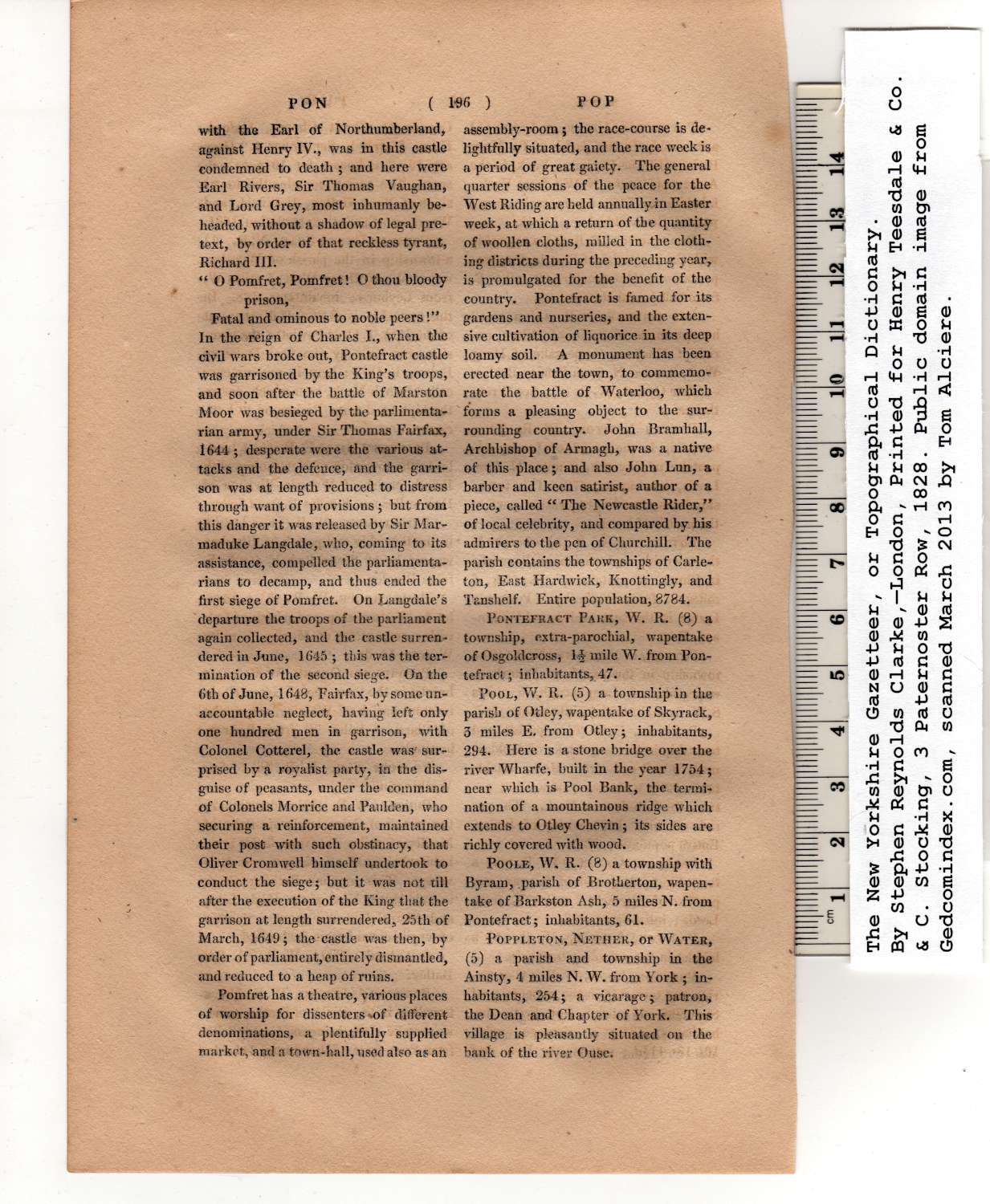|
with the Earl of Northumberland,
against Henry IV., was in this castle
condemned to death ; and here were
Earl Rivers, Sir Thomas Vaughan,
and Lord Grey, most inhumanly be-
headed, without a shadow of legal pre-
text, by order of that reckless tyrant,
Richard III.
“ O Pomfret, Pomfret! O thou bloody
prison,
Fatal and ominous to noble peers 1”
In the reign of Charles I., when the
civil wars broke out, Pontefract castle
was garrisoned by the King’s troops,
and soon after the battle of Marston
Moor was besieged by the parlimenta-
rian army, under Sir Thomas Fairfax,
1644 ; desperate were the various at-
tacks and the defence, and the garri-
son was at length reduced to distress
through want of provisions; hut from
this danger it was released by Sir Mar-
maduke Langdale, who, coming to its
assistance, compelled the parliamenta-
rians to decamp, and thus ended the
first siege of Pomfret. On Langdale’s
departure the troops of the parliament
again collected, and the castle surren-
dered in June, 1645 ; this was the ter-
mination of the second siege. On the
6th of June, 1648, Fairfax, by some un-
accountable neglect, having left only
one hundred men in garrison, with
Colonel Cotterel, the castle was sur-
prised by a royalist party, in the dis-
guise of peasants, under the command
of Colonels Morrice and Paulden, who
securing a reinforcement, maintained
their post with such obstinacy, that
Oliver Cromwell himself undertook to
conduct the siege; but it was not till
after the execution of the King that the
garrison at length surrendered, 25 th of
March, 1649; the castle was then, by
order of parliament, entirely dismantled,
and reduced to a heap of ruins. |
Pomfret has a theatre, various places
of worship for dissenters of different
denominations, a plentifully supplied
market, and a town-hali, used also as an
assembly-room; the race-course is de-
lightfully situated, and the race week is
a period of great gaiety. The general
quarter sessions of the peace for the
West Riding are held annually in Easter
week, at which a return of the quantity
of woollen cloths, milled in the cloth-
ing districts during the preceding year,
is promulgated for the benefit of the
country. Pontefract is famed for its
gardens and nurseries, and the exten-
sive cultivation of liquorice in its deep
loamy soil. A monument has been
erected near the town, to commemo-
rate the battle of Waterloo, which
forms a pleasing object to the sur-
rounding country. John Bramhall,
Archbishop of Armagh, was a native
of this place; and also John Lun, a
barber and keen satirist, author of a
piece, called “ The Newcastle Rider,”
of local celebrity, and compared by his
admirers to the pen of Churchill. The
parish contains the townships of Carle-
ton, East Hardwick, Knottingly, and
Tanshelf. Entire population, 8784.
Pontefract Park, W. R. (8) a
township, extra-parochial, wapentake
of Osgoldcross, 1§ mile W. from Pon-
tefract ; inhabitants, 47.
Pool, W. R. (5) a township in the
parish of Otley, wapentake of Skyrack,
3 miles E. from Otley; inhabitants,
294. Here is a stone bridge over the
river Wharfe, built in the year 1754;
near which is Pool Bank, the termi-
nation of a mountainous ridge which
extends to Otley Chevin; its sides are
richly covered with wood.
Poole, W. R. (8) a township with
Byram, parish of Brotherton, wapen-
take of Barkston Ash, 5 miles N. from
Pontefract; inhabitants, 61.
Poppleton, Nether, or Water,
(5) a parish and township in the
Ainsty, 4 miles N. W. from York ; in-
habitants, 254; a vicarage; patron,
the Dean and Chapter of York. This
village is pleasantly situated on the
bank of the river Ouse. |
